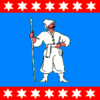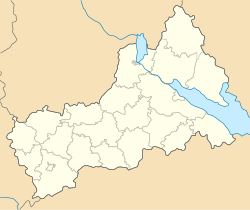Uman, Ukraine
|
Uman Умань |
|||
|---|---|---|---|
| City | |||
 |
|||
|
|||
| Location of Uman | |||
| Coordinates: 48°45′0″N 30°13′0″E / 48.75000°N 30.21667°ECoordinates: 48°45′0″N 30°13′0″E / 48.75000°N 30.21667°E | |||
|
Country Oblast Municipality |
Ukraine Cherkasy Oblast Uman |
||
| Founded | 1616 | ||
| Magdeburg rights | 1760 | ||
| Government | |||
| • Mayor | Oleksandr Tsebriy | ||
| Area | |||
| • Total | 41 km2 (16 sq mi) | ||
| Elevation | 166 m (545 ft) | ||
| Population (2010) | |||
| • Total | 86 911 | ||
| • Density | 2,154/km2 (5,580/sq mi) | ||
| Postal code | 20300 | ||
| Area code(s) | +380 4744 | ||
Uman (Ukrainian: Умань, Ukrainian pronunciation: [ˈumɑnʲ]; Polish: Humań) is a city located in the Cherkasy Oblast (province) in central Ukraine, to the east of Vinnytsia. Located in the historical region of the eastern Podolia, the city rests on the banks of the Umanka River at around 48°45′N 30°13′E / 48.750°N 30.217°E, and serves as the self-governing administrative center of the Uman Raion (district).
Among Ukrainians, Uman is known for its depiction of the haidamak rebellions in Taras Shevchenko's longest of poems, Haidamaky ("The Haidamaks", 1843). The city is also a pilgrimage site for Breslov Hasidic Jews and a major center of gardening research containing the dendrological park Sofiyivka and the University of Gardening.
Uman (Humań) was a privately-owned city of Poland and the Polish-Lithuanian Commonwealth.
...
Wikipedia



